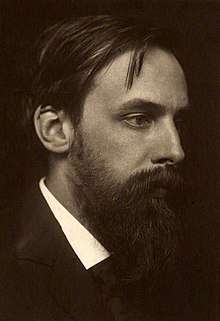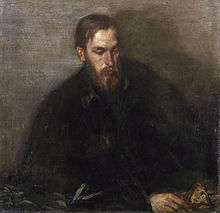Thomas Sturge Moore
Thomas Sturge Moore (4 March 1870 – 18 July 1944) was a British poet, author and artist.
Thomas Sturge Moore | |
|---|---|
 Thomas Sturge Moore by George Charles Beresford, 1903 | |
| Born | 4 March 1870 3 Wellington Square, Hastings, East Sussex |
| Died | 18 July 1944 St Andrews Cottage, Clewer, Windsor, Berkshire |
| Resting place | Ashes scattered near Petersfield, Hampshire |
| Occupation | Poet, writer and artist |
| Education | Dulwich College Croydon School of Art Lambeth School of Art |
| Genre | Georgian Poetry Noh drama Art nouveau Art deco |
| Spouse | Marie Appia (1872–1956) |
| Children | Daniel Sturge-Moore (1908–1980) Riette Sturge-Moore (1907–1995) |
| Relatives | G.E. Moore (brother) Nicholas Moore (nephew) |

Biography
Sturge Moore was born at 3 Wellington Square, Hastings, East Sussex, on 4 March 1870 and educated at Dulwich College, the Croydon School of Art and Lambeth School of Art.[1][2] In Lambeth he studied under the wood-engraver Charles Roberts. He was a long-term friend and correspondent of W. B. Yeats, who was to describe him as "one of the most exquisite poets writing in England". He was also a playwright, writing a Medea influenced by Yeats' drama and the Japanese Noh style. As a wood-engraver and artist he designed the covers for poetry editions of Yeats and others.[3][4]
He was a prolific poet and his subjects included morality, art and the spirit writing in a 'severely classical tone', according to poet/critic Yvor Winters.[3] His first pamphlet, Two Poems, was printed privately in 1893 and his first book of verse, The Vinedresser, was published in 1899. His love for poetry led him to become an active member of the Poetry Recital Society.
In 1901, Moore, with Yeats, Laurence Binyon, Charles Ricketts, and Ethel and Sybil Pye, formed the Literary Theatre Club. Moore's first (of 31) play to be produced, a copyright reading of Aphrodite against Artemis, was the first production staged by the club, at the Dalston Theatre on 30 July 1901. Yeats described the play as "powerful with a beautiful constrained passion."[5]
In 1913 Moore nominated Rabindranath Tagore the Indian poet for the Nobel Prize in literature.
Moore received a civil list pension of £75 per annum in 1920 in recognition of his contribution to literature. In 1930 he was nominated as one of seven candidates for the position of Poet Laureate. He suffered from chronic ill health, suffering a series of heart attacks in 1942 and 1943, and died on 18 July 1944 at a convalescent home, St Andrews Cottage in Clewer, Windsor, Berkshire, from a kidney infection following a prostate operation.[4][6][7][8]
He was cremated at Woking.[4] His ashes were scattered near Petersfield in August 1953.[9]
Family
Sturge Moore adopted the use of his middle name 'Sturge' (his mother's family name) as a way of avoiding confusion with the poet Thomas Moore.[4]
On 26 November 1903 Moore married Marie Appia, niece of Louis Appia, a founder of the International Committee of the Red Cross, and cousin of the Swiss stage designer Adolphe Appia.[10] They had two children: Daniel Sturge-Moore, journalist and broadcaster; and Henriette Sturge-Moore, prominent theatre designer, teacher and interior decorator.[11][12][13]
Moore was the brother of the Bloombury philosopher George Edward Moore, one of the founders of the Analytic tradition in philosophy, and uncle of Nicholas Moore, New Apocalyptics poet of the 1940s, and of the composer Timothy Moore.[1][4][14]
Works
- Two Poems, 1893
- The Vinedresser and Other Poems, 1899
- The Centaur and the Bacchant. From the French by Maurice de Guerin, 1899
- Altdorfer, 1900
- Aphrodite Against Artemis, 1901 (play)
- Absalom, 1903 (poems)
- Danäe, 1903 (poems)
- Durer, 1904
- The Little School, 1905 (poems)
- Poems, 1906
- Correggio, 1906
- Art and Life (Flaubert and Blake), 1910
- Mariamne, 1911 (poems)
- A Sicilian Idyll and Judith: A Conflict, 1911 (play)
- The Sea is Kind, 1914 (collection of 69 poems)
- The Wilderness, 1915 (poetic drama)
- Medea, 1920 (play)
- Tragic Mothers: Medea, Niobe, Tyrfing, 1920 (play)
- Mystery and Tragedy: Two Dramatic Poems, 1930 (play)
References
- Hodges, S, (1981), God's Gift: A Living History of Dulwich College, pp. 87-88 (Heinemann: London)
- Moore, Thomas Sturge. "Thomas Sturge Moore Papers". Archives & Manuscripts. Senate House Library, University of London. Retrieved 11 February 2014.
- Untermeyer, Louis, Modern British Poetry, Doubleday and Page & Co, 1920
- Gwynn, Frederick L. (1951). Sturge Moore and the Life of Art (PDF). Lawrence, Kansas: University of Kansas Press. Retrieved 15 April 2018.
- Schuchard, Ronald (2008). The Last Minstrels : Yeats and the Revival of the Bardic Arts. Oxford University Press. pp. 41–48. ISBN 9780191528064. Retrieved 14 October 2014.
- Public Records Office. "1944". England & Wales, National Probate Calendar (Index of Wills and Administrations), 1858-1966. Kew, Surrey: The National Archives. p. 756.
- Kelly, John. "Moore, Thomas Sturge". Oxford Dictionary of National Biography. Oxford University Press. Retrieved 8 June 2014.
- Bowers, Jr., William Edgar (1953). The Poetry of Sturge Moore. Stanford, CA: Dept. of English, Stanford University. p. iv.
- Aggett, Viv. "Sturge Moore family papers (reference MS1159)" (PDF). Senate House Library. University of London. p. 4. Retrieved 15 April 2018.
- Yeats, W.B. (1986). Kelly, John; Schuchard, Ronald (eds.). The Collected Letters of W. B. Yeats: Volume IV, 1905-1907. Oxford: OUP. p. 398. ISBN 9780198126843. Retrieved 19 January 2018.
- Brett, Charles Edward Bainbridge (1978). Long shadows cast before: nine lives in Ulster, 1625-1977. Edinburgh: J. Bartholomew. p. 45. ISBN 9780702810589. Retrieved 14 October 2014.
- Dunlop, Frank (24 October 1995). "Obituary: Riette Sturge Moore". The Independent. London. Retrieved 14 October 2014.
- Legge, Silvia (1980). Affectionate Cousins: T. Sturge Moore and Marie Appia. Oxford University Press. ISBN 9780192117618.
- Marshall, Nicholas (10 March 2003). "Timothy Moore". The Guardian. Retrieved 14 March 2014.
External links
| Wikiquote has quotations related to: Thomas Sturge Moore |
| Wikisource has original works written by or about: Thomas Sturge Moore |
- "Sturge Moore and the Life of Art" by Frederick L. Gwynn (University of Kansas Press, Lawrence, 1951). 159 pages, includes "A Bibliography of Sturge Moore." Open access full-text PDF file available from the University of Kansas.
- Papers of Thomas Sturge Moore in Senate House Library, University of London
- Works by Thomas Sturge Moore at Project Gutenberg
- Works by or about Thomas Sturge Moore at Internet Archive
- The Wilderness (1915) at Great War Theatre
- Stuart A. Rose Manuscript, Archives, and Rare Book Library, Emory University: T. Sturge Moore collection, 1928-1934